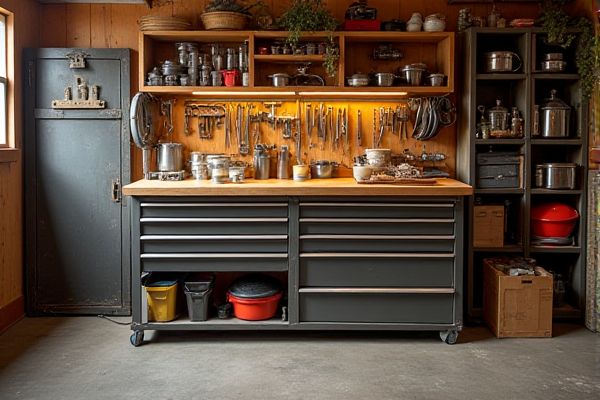
A workbench provides a flat, stable surface ideal for assembling projects and detailed tasks, while a tool chest offers organized storage with multiple drawers to keep your tools easily accessible and secure. To find out which option best suits Your workspace needs, continue reading the rest of the article.
Table of Comparison
| Feature | Workbench | Tool Chest |
|---|---|---|
| Primary Use | Flat surface for assembly, repairs, and projects | Storage and organization of tools |
| Design | Sturdy table, sometimes with drawers or shelves | Box or cabinet with multiple drawers and compartments |
| Portability | Usually stationary or heavy | Can be portable or stationary, often with wheels |
| Capacity | Supports workpieces and tools during projects | Holds and organizes large tools and accessories |
| Material | Wood, metal, or composite tops with metal frames | Metal or heavy-duty plastic for durability |
| Common Locations | Workshops, garages, labs | Workshops, garages, construction sites |
| Cost Range | $100 - $1000+ | $50 - $2000+ |
Overview: Workbench vs Tool Chest
A workbench provides a sturdy surface for assembling, repairing, and organizing tools while often featuring built-in storage or pegboards for accessibility. A tool chest primarily serves as a portable storage solution designed to keep your hand tools, power tools, and accessories organized and secure. Choosing between a workbench and a tool chest depends on whether your priority is workspace functionality or tool storage efficiency.
Core Functions and Differences
A workbench provides a sturdy surface for assembling, repairing, and crafting tasks, often including storage drawers to keep essential tools organized and within reach. In contrast, a tool chest primarily focuses on tool storage with multiple drawers and compartments designed to protect and sort various hand tools efficiently. While workbenches emphasize a functional workspace for hands-on projects, tool chests prioritize maximum storage capacity and portability for tools.
Design and Structure Comparison
Workbench designs prioritize open, flat surfaces with integrated storage compartments and pegboards, offering easy access to frequently used tools during complex projects. In contrast, tool chests feature multiple stacked drawers with organized dividers, designed for compact storage and mobility, ideal for keeping small tools and parts systematically arranged. Your choice depends on whether you require a spacious work area with accessible tool storage or a portable, space-efficient solution for tool organization.
Storage Capacity and Organization
Workbench and tool chest differ significantly in storage capacity and organization; a workbench typically offers larger overall storage space with open shelves and compartments ideal for bulky tools and quick access. Tool chests provide compact, segmented drawers designed for precise organization of smaller tools, maximizing efficiency and reducing clutter. Your choice depends on whether you prioritize extensive storage and workspace or detailed tool organization and portability.
Mobility and Space Efficiency
A workbench often features a sturdy, stationary design that maximizes workspace surface but limits mobility, making it ideal for larger projects requiring stability. In contrast, a tool chest typically offers compact storage with multiple drawers and wheels, allowing you to easily move tools around your workspace while conserving floor space. Your choice depends on whether you prioritize a stable work surface or the ability to efficiently transport and organize tools in tight areas.
Material Durability and Build Quality
Workbench construction typically features heavy-duty steel or reinforced hardwood, ensuring superior durability and stability for demanding tasks, while tool chests often use steel or aluminum for robust, long-lasting storage with better portability. Workbenches are engineered to withstand heavy impacts and constant pressure, with thick legs and reinforced surfaces that resist warping and wear over time. Tool chests prioritize secure drawer mechanisms and corrosion-resistant coatings, maintaining structural integrity and protecting tools during transportation and frequent use.
Suitability for Different Workspaces
Workbench and tool chest serve distinct purposes tailored to different workspace needs; workbenches provide a flat, sturdy surface ideal for assembly and repairs, making them suitable for workshops requiring extensive hands-on tasks. Tool chests excel in compact storage, offering organized compartments and portability, perfect for small or mobile workspaces where efficient tool access is crucial. Your choice depends on whether your workspace prioritizes a dedicated work area or optimized tool storage.
Accessibility and Workflow Optimization
Workbench designs prioritize accessibility by providing an open, flat surface with easy reach to tools and materials, enhancing immediate workflow efficiency during detailed tasks. Tool chests optimize workflow by organizing tools in compact, categorized drawers that reduce clutter and speed up retrieval but may require additional steps to access compared to a workbench. Combining both elements facilitates a balanced workspace where quick access meets systematic storage, maximizing overall productivity in various work environments.
Cost Comparison and Value
Workbench and tool chest costs vary significantly based on size, material, and features, with workbenches generally priced higher due to their larger surface area and integrated storage options. Tool chests offer a more budget-friendly storage solution while maximizing organization through multiple drawers, making them ideal for users prioritizing tool accessibility. Evaluating value depends on workspace needs; workbenches provide multifunctional work surfaces plus storage, whereas tool chests optimize compact tool management and portability.
Choosing the Right Solution for Your Needs
Workbench and tool chest serve distinct purposes for organizing and accessing tools, making the choice dependent on your specific workflow and space requirements. Workbenches provide a stable surface with integrated storage, ideal for tasks needing a sturdy workspace combined with tool accessibility. Tool chests offer compact, mobile storage solutions with multiple drawers, suited for maximizing organization and portability in smaller or dynamic work environments.
 homyna.com
homyna.com